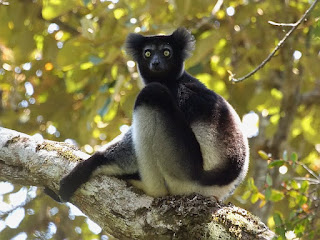
The indri, also known as the babakoto, is one of the largest living lemurs, measuring 64–72 cm in length and weighing between 6 and 9.5 kg. It has a black and white coat and climbs or clings in an upright position.
Indri can grow to be between 21 and 28 inches long. The weight ranges from 13 to 21 pounds.
The color of the indri’s coat blends in with its surroundings and serves as a deterrent to predators. Indri can be entirely brown or black, or he can be covered in white and red patches.
Indri, unlike other lemurs, has a very short tail that is less than 2 inches long.
Indri has round ears and forward-facing yellow eyes. Their fingers are very dexterous, which helps them move quickly through dense vegetation.
Indri spends the majority of its time in the trees. It moves horizontally by leapfrogging from one branch to the next.
Indri has a 33-foot leaping ability.
Indri is a carnivore (plant-eating animal). It feeds on a variety of leaves, flowers, fruits, and seeds.
Indri is a diurnal (daytime active) animal.
Indri prefers to live in small family groups of 2 to 6 animals. Members of the group communicate using distinct, high-pitched calls that can be heard from up to 1.2 miles away. Indris are territorial animals that mark the boundaries of their territories with urine.
Indris possesses a keen sense of smell. They can detect urine markings and thus avoid clashes with animals living on the territory they are approaching.
Females, unlike other primates, are dominant members of the group. They will eat first, while the males will protect the territory.
The mating season occurs in the winter. The Indris is a monogamous species (one couple mate for a lifetime).
Female pregnancies last 4 to 5 months and result in one baby. Babies are typically born between May and June.
Young indris will spend the first few months of their lives attached to their mothers’ bellies. They will later ride on their mothers’ backs. At the age of eight months, young indris become self-sufficient from their mothers.
Despite their independence, they will stay with them until they are 2 to 3 years old.
Indris reach sexual maturity late in life (between the ages of 8 and 9) and reproduce every 2 to 3 years. This is why the number of indris in the wild cannot increase rapidly.
In the wild, indri have a lifespan of 15 to 18 years. Indri cannot live in captivity for an extended period of time.









The author used a variety of multimedia elements in this post, such as images or videos, to help illustrate their points. Multimedia elements can be a great way to make a post more engaging and memorable, and the author of this post used them effectively.
Your article gave me a lot of inspiration, I hope you can explain your point of view in more detail, because I have some doubts, thank you.